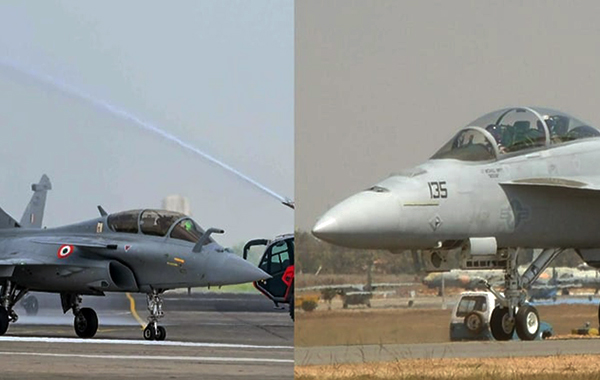The Indian Navy has fast-tracked the process of purchasing 26 fighter jets for its two aircraft carriers after evaluating the trial report of the two shortlisted contenders — F/A 18 Super Hornet of Boeing and the Rafale of Dassault Aviation.
The Super Hornets are US-made while the Rafale is manufactured by France. The Navy needs 26 jets for the two aircraft carriers — INS Vikramaditya and INS Vikrant.
The Navy has carried out trials of both the aircraft from its shore-based facility, INS Hansa in Goa, which is a replica of an aircraft carrier deck.
“The trial team submitted its report to the Naval headquarters recently after carrying out extensive trials at its Goa-based facility. The evaluation process is at an advanced stage and is expected to be completed very soon,” top government sources told India Today TV.
The two contenders in the tender have given extensive details of their planes to the Navy and all the issues would be taken into consideration before arriving at the plane to be shortlisted for the carrier-based operations, they said.
The jets are required for operations on the INS Vikrant aircraft carrier as the MiG-29s are found to be sufficient only for the operational readiness requirements of the first aircraft carrier, INS Vikramaditya, the sources added.
INS Vikrant is without an element of fighter aircraft as trials are supposed to be conducted by the end of this year. The Navy earlier required 57 planes for operations on both the carriers, but the requirement was cut short by more than half in support of indigenous planes.
The Navy is looking at getting the 26 aircraft within three years of the order being placed. Out of the 26, the Navy wants eight two-seaters for training purposes. However, the Rafale is a single-seater, while the Super Hornet comes in both configurations.
One advantage that the Super Hornet has over the Rafale is the foldable wings, which reduce its wing span from 44 feet to 30 feet, making it more flexible to be accommodated. The Super Hornet can carry four anti-ship missiles compared to one on the Rafale. The Super Hornet with a maximum take off weight is 29,900 kg, while the Rafale is 24,500 kg.
Sources said once the Navy zeroes in on the choice, it will likely be a government-to-government deal like the one for getting 36 Rafale jets for the Indian Air Force.
The navy is looking at an aircraft that can operate from both STOBAR (Short take off- but arrested recovery) and CATOBAR (Catapult Take-off but arrested recovery) aircraft carriers. The STOBAR carriers come with a ski-jump ramp while the CATOBARs are flat deck. Indian Navy’s two carriers INS Vikramaditya and newly inducted INS Vikrant are both STOBAR carriers. The third carrier under planning is likely to be a CATOBAR and keeping that in mind, the navy’s requirement is to have a fighter jet that can operate from both, as the current MiG 29s are limited to the two STOBAR carriers of the Indian Navy.
A CATOBAR carrier can have a bigger impact as it increases range, has more weapons and can operate a variety of aircraft.
Super Hornet and Rafale are suited for CATOBAR carriers but the tests that have taken place are from the navy’s shore-based facility in Goa that has a ski-jump and is identical to the two aircraft carriers India has.
The original Navy plan was to buy 57 fighters but there have been delays. Sources said now the navy is speeding up the process for the critical acquisition of at least 26 aircraft. The Navy currently has a fleet of 40 plus MiG 29 K aircraft but will need replacement at some point of time. With 18-20 aircraft operating from each carrier if a third one indeed gets a go-ahead surely more fighters would be needed. In the Indian Navy’s plans is a third carrier, even though it might be a distant dream as of now. The MiG 29 Ks were inducted in 2010 and the first squadron commissioned in 2013 to operate from INS Vikramaditya.













